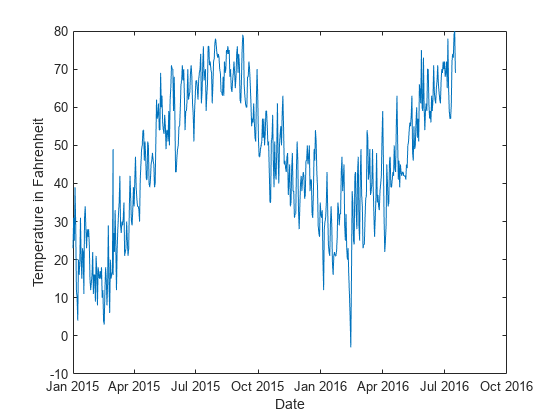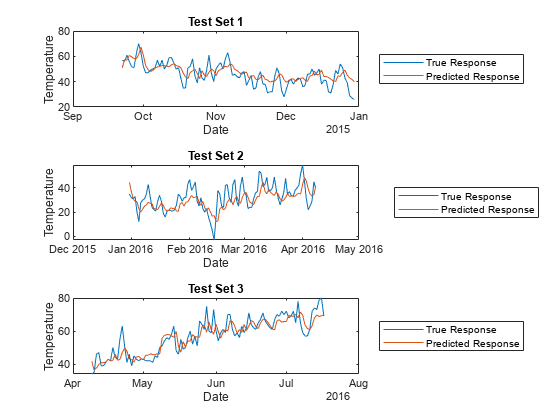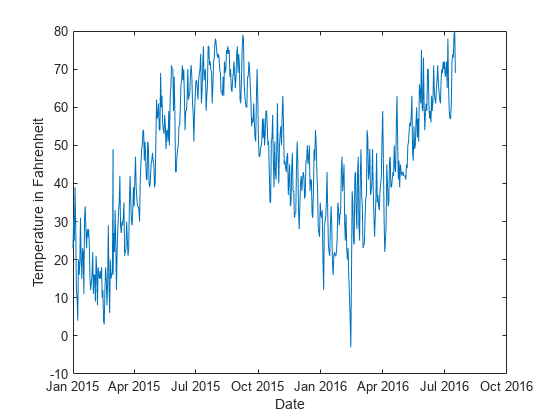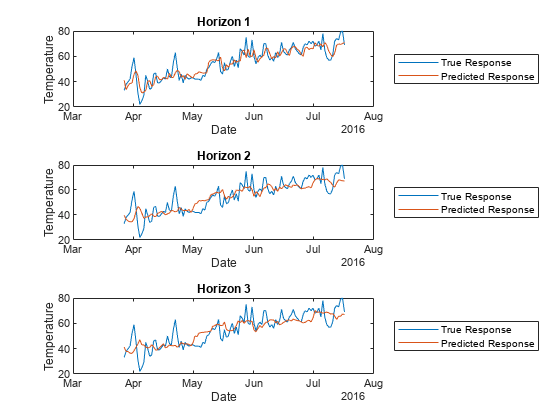cvpredict
Description
predictedY = cvpredict(CVMdl)CVMdl. For each partition window in
CVMdl.Partition and each horizon step in
CVMdl.Horizon, the function predicts the response for test observations
by using a model trained on training observations. If an observation is in more than one
test set, the function returns the prediction for that observation, averaged over all test
sets.
Examples
Create a cross-validated direct forecasting model using expanding window cross-validation. To evaluate the performance of the model:
Compute the mean squared error (MSE) on each test set using the
cvlossobject function.For each test set, compare the true response values to the predicted response values using the
cvpredictobject function.
Load the sample file TemperatureData.csv, which contains average daily temperature from January 2015 through July 2016. Read the file into a table. Observe the first eight observations in the table.
Tbl = readtable("TemperatureData.csv");
head(Tbl) Year Month Day TemperatureF
____ ___________ ___ ____________
2015 {'January'} 1 23
2015 {'January'} 2 31
2015 {'January'} 3 25
2015 {'January'} 4 39
2015 {'January'} 5 29
2015 {'January'} 6 12
2015 {'January'} 7 10
2015 {'January'} 8 4
Create a datetime variable t that contains the year, month, and day information for each observation in Tbl.
numericMonth = month(datetime(Tbl.Month, ... InputFormat="MMMM",Locale="en_US")); t = datetime(Tbl.Year,numericMonth,Tbl.Day);
Plot the temperature values in Tbl over time.
plot(t,Tbl.TemperatureF) xlabel("Date") ylabel("Temperature in Fahrenheit")

Create a direct forecasting model by using the data in Tbl. Train the model using a bagged ensemble of trees. All three of the predictors (Year, Month, and Day) are leading predictors because their future values are known. To create new predictors by shifting the leading predictor and response variables backward in time, specify the leading predictor lags and the response variable lags.
Mdl = directforecaster(Tbl,"TemperatureF", ... Learner="bag", ... LeadingPredictors="all",LeadingPredictorLags={0:1,0:1,0:7}, ... ResponseLags=1:7)
Mdl =
DirectForecaster
Horizon: 1
ResponseLags: [1 2 3 4 5 6 7]
LeadingPredictors: [1 2 3]
LeadingPredictorLags: {[0 1] [0 1] [0 1 2 3 4 5 6 7]}
ResponseName: 'TemperatureF'
PredictorNames: {'Year' 'Month' 'Day'}
CategoricalPredictors: 2
Learners: {[1×1 classreg.learning.regr.CompactRegressionEnsemble]}
MaxLag: 7
NumObservations: 565
Properties, Methods
Mdl is a DirectForecaster model object. By default, the horizon is one step ahead. That is, Mdl predicts a value that is one step into the future.
Partition the time series data in Tbl using an expanding window cross-validation scheme. Create three training sets and three test sets, where each test set has 100 observations. Note that each observation in Tbl is in at most one test set.
CVPartition = tspartition(size(Mdl.X,1),"ExpandingWindow",3, ... TestSize=100)
CVPartition =
tspartition
Type: 'expanding-window'
NumObservations: 565
NumTestSets: 3
TrainSize: [265 365 465]
TestSize: [100 100 100]
StepSize: 100
Properties, Methods
The training sets increase in size from 265 observations in the first window to 465 observations in the third window.
Create a cross-validated direct forecasting model using the partition specified in CVPartition. Inspect the Learners property of the resulting CVMdl object.
CVMdl = crossval(Mdl,CVPartition)
CVMdl =
PartitionedDirectForecaster
Partition: [1×1 tspartition]
Horizon: 1
ResponseLags: [1 2 3 4 5 6 7]
LeadingPredictors: [1 2 3]
LeadingPredictorLags: {[0 1] [0 1] [0 1 2 3 4 5 6 7]}
ResponseName: 'TemperatureF'
PredictorNames: {'Year' 'Month' 'Day'}
CategoricalPredictors: 2
Learners: {3×1 cell}
MaxLag: 7
NumObservations: 565
Properties, Methods
CVMdl.Learners
ans=3×1 cell array
{1×1 timeseries.forecaster.CompactDirectForecaster}
{1×1 timeseries.forecaster.CompactDirectForecaster}
{1×1 timeseries.forecaster.CompactDirectForecaster}
CVMdl is a PartitionedDirectForecaster model object. The crossval function trains CVMdl.Learners{1} using the observations in the first training set, CVMdl.Learner{2} using the observations in the second training set, and CVMdl.Learner{3} using the observations in the third training set.
Compute the average test set MSE.
averageMSE = cvloss(CVMdl)
averageMSE = 53.3480
To obtain more information, compute the MSE for each test set.
individualMSE = cvloss(CVMdl,Mode="individual")individualMSE = 3×1
44.1352
84.0695
31.8393
The models trained on the first and third training sets seem to perform better than the model trained on the second training set.
For each test set observation, predict the temperature value using the corresponding model in CVMdl.Learners.
predictedY = cvpredict(CVMdl); predictedY(260:end,:)
ans=306×1 table
TemperatureF_Step1
__________________
NaN
NaN
NaN
NaN
NaN
NaN
50.963
57.363
57.04
60.705
59.606
58.302
58.023
61.39
67.229
61.083
⋮
Only the last 300 observations appear in any test set. For observations that do not appear in a test set, the predicted response value is NaN.
For each test set, plot the true response values and the predicted response values.
tiledlayout(3,1) nexttile idx1 = test(CVPartition,1); plot(t(idx1),Tbl.TemperatureF(idx1)) hold on plot(t(idx1),predictedY.TemperatureF_Step1(idx1)) legend("True Response","Predicted Response", ... Location="eastoutside") xlabel("Date") ylabel("Temperature") title("Test Set 1") hold off nexttile idx2 = test(CVPartition,2); plot(t(idx2),Tbl.TemperatureF(idx2)) hold on plot(t(idx2),predictedY.TemperatureF_Step1(idx2)) legend("True Response","Predicted Response", ... Location="eastoutside") xlabel("Date") ylabel("Temperature") title("Test Set 2") hold off nexttile idx3 = test(CVPartition,3); plot(t(idx3),Tbl.TemperatureF(idx3)) hold on plot(t(idx3),predictedY.TemperatureF_Step1(idx3)) legend("True Response","Predicted Response", ... Location="eastoutside") xlabel("Date") ylabel("Temperature") title("Test Set 3") hold off

Overall, the cross-validated direct forecasting model is able to predict the trend in temperatures. If you are satisfied with the performance of the cross-validated model, you can use the full DirectForecaster model Mdl for forecasting at time steps beyond the available data.
Create a partitioned direct forecasting model using holdout validation. To evaluate the performance of the model:
At each horizon step, compute the root relative squared error (RRSE) on the test set using the
cvlossobject function.At each horizon step, compare the true response values to the predicted response values using the
cvpredictobject function.
Load the sample file TemperatureData.csv, which contains average daily temperature from January 2015 through July 2016. Read the file into a table. Observe the first eight observations in the table.
Tbl = readtable("TemperatureData.csv");
head(Tbl) Year Month Day TemperatureF
____ ___________ ___ ____________
2015 {'January'} 1 23
2015 {'January'} 2 31
2015 {'January'} 3 25
2015 {'January'} 4 39
2015 {'January'} 5 29
2015 {'January'} 6 12
2015 {'January'} 7 10
2015 {'January'} 8 4
Create a datetime variable t that contains the year, month, and day information for each observation in Tbl.
numericMonth = month(datetime(Tbl.Month, ... InputFormat="MMMM",Locale="en_US")); t = datetime(Tbl.Year,numericMonth,Tbl.Day);
Plot the temperature values in Tbl over time.
plot(t,Tbl.TemperatureF) xlabel("Date") ylabel("Temperature in Fahrenheit")

Create a direct forecasting model by using the data in Tbl. Specify the horizon steps as one, two, and three steps ahead. Train a model at each horizon using a bagged ensemble of trees. All three of the predictors (Year, Month, and Day) are leading predictors because their future values are known. To create new predictors by shifting the leading predictor and response variables backward in time, specify the leading predictor lags and the response variable lags.
rng("default") Mdl = directforecaster(Tbl,"TemperatureF", ... Horizon=1:3,Learner="bag", ... LeadingPredictors="all",LeadingPredictorLags={0:1,0:1,0:7}, ... ResponseLags=1:7)
Mdl =
DirectForecaster
Horizon: [1 2 3]
ResponseLags: [1 2 3 4 5 6 7]
LeadingPredictors: [1 2 3]
LeadingPredictorLags: {[0 1] [0 1] [0 1 2 3 4 5 6 7]}
ResponseName: 'TemperatureF'
PredictorNames: {'Year' 'Month' 'Day'}
CategoricalPredictors: 2
Learners: {3×1 cell}
MaxLag: 7
NumObservations: 565
Properties, Methods
Mdl is a DirectForecaster model object. Mdl consists of three regression models: Mdl.Learners{1}, which predicts one step ahead; Mdl.Learners{2}, which predicts two steps ahead; and Mdl.Learners{3}, which predicts three steps ahead.
Partition the time series data in Tbl using a holdout validation scheme. Reserve 20% of the observations for testing.
holdoutPartition = tspartition(size(Mdl.X,1),"Holdout",0.20)holdoutPartition =
tspartition
Type: 'holdout'
NumObservations: 565
NumTestSets: 1
TrainSize: 452
TestSize: 113
Properties, Methods
The test set consists of the latest 113 observations.
Create a partitioned direct forecasting model using the partition specified in holdoutPartition.
holdoutMdl = crossval(Mdl,holdoutPartition)
holdoutMdl =
PartitionedDirectForecaster
Partition: [1×1 tspartition]
Horizon: [1 2 3]
ResponseLags: [1 2 3 4 5 6 7]
LeadingPredictors: [1 2 3]
LeadingPredictorLags: {[0 1] [0 1] [0 1 2 3 4 5 6 7]}
ResponseName: 'TemperatureF'
PredictorNames: {'Year' 'Month' 'Day'}
CategoricalPredictors: 2
Learners: {[1×1 timeseries.forecaster.CompactDirectForecaster]}
MaxLag: 7
NumObservations: 565
Properties, Methods
holdoutMdl is a PartitionedDirectForecaster model object. Because holdoutMdl uses holdout validation rather than a cross-validation scheme, the Learners property of the object contains one CompactDirectForecaster model only.
Like Mdl, holdoutMdl contains three regression models. The crossval function trains holdoutMdl.Learners{1}.Learners{1}, holdoutMdl.Learners{1}.Learners{2}, and holdoutMdl.Learners{1}.Learners{3} using the same training data. However, the three models use different response variables because each model predicts values for a different horizon step.
holdoutMdl.Learners{1}.Learners{1}.ResponseNameans = 'TemperatureF_Step1'
holdoutMdl.Learners{1}.Learners{2}.ResponseNameans = 'TemperatureF_Step2'
holdoutMdl.Learners{1}.Learners{3}.ResponseNameans = 'TemperatureF_Step3'
Compute the root relative squared error (RRSE) on the test data at each horizon step. Use the helper function computeRRSE (shown at the end of this example). The RRSE indicates how well a model performs relative to the simple model, which always predicts the average of the true values. In particular, when the RRSE is less than 1, the model performs better than the simple model.
holdoutRRSE = cvloss(holdoutMdl,LossFun=@computeRRSE)
holdoutRRSE = 1×3
0.4797 0.5889 0.6103
At each horizon, the direct forecasting model seems to perform better than the simple model.
For each test set observation, predict the temperature value using the corresponding model in holdoutMdl.Learners.
predictedY = cvpredict(holdoutMdl); predictedY(450:end,:)
ans=116×3 table
TemperatureF_Step1 TemperatureF_Step2 TemperatureF_Step3
__________________ __________________ __________________
NaN NaN NaN
NaN NaN NaN
NaN NaN NaN
41.063 39.758 41.234
33.721 36.507 37.719
36.987 35.133 37.719
38.644 34.598 36.444
38.917 34.576 36.275
45.888 37.005 38.34
48.516 42.762 41.05
44.882 46.816 43.881
35.057 45.301 47.048
31.1 41.473 42.948
31.817 37.314 42.946
33.166 38.419 41.3
40.279 38.432 40.533
⋮
Recall that only the latest 113 observations appear in the test set. For observations that do not appear in the test set, the predicted response value is NaN.
For each test set, plot the true response values and the predicted response values.
tiledlayout(3,1) idx = test(holdoutPartition); nexttile plot(t(idx),Tbl.TemperatureF(idx)) hold on plot(t(idx),predictedY.TemperatureF_Step1(idx)) legend("True Response","Predicted Response", ... Location="eastoutside") xlabel("Date") ylabel("Temperature") title("Horizon 1") hold off nexttile plot(t(idx),Tbl.TemperatureF(idx)) hold on plot(t(idx),predictedY.TemperatureF_Step2(idx)) legend("True Response","Predicted Response", ... Location="eastoutside") xlabel("Date") ylabel("Temperature") title("Horizon 2") hold off nexttile plot(t(idx),Tbl.TemperatureF(idx)) hold on plot(t(idx),predictedY.TemperatureF_Step3(idx)) legend("True Response","Predicted Response", ... Location="eastoutside") xlabel("Date") ylabel("Temperature") title("Horizon 3") hold off

Overall, holdoutMdl is able to predict the trend in temperatures, although it seems to perform best when forecasting one step ahead. If you are satisfied with the performance of the partitioned model, you can use the full DirectForecaster model Mdl for forecasting at time steps beyond the available data.
Helper Function
The helper function computeRRSE computes the RRSE given the true response variable trueY and the predicted values predY. This code creates the computeRRSE helper function.
function rrse = computeRRSE(trueY,predY) error = trueY(:) - predY(:); meanY = mean(trueY(:),"omitnan"); rrse = sqrt(sum(error.^2,"omitnan")/sum((trueY(:) - meanY).^2,"omitnan")); end
Input Arguments
Cross-validated direct forecasting model, specified as a PartitionedDirectForecaster model object.
Output Arguments
Predicted responses, returned as a numeric matrix, table, or timetable.
predictedY has the same data type as CVMdl.Y
and is of size n-by-h, where n
is the number of observations (CVMdl.NumObservations) and
h is the number of horizon steps (that is, the number of elements
in CVMdl.Horizon).
predictedY contains NaN values for
observations that are not included in any test set. To identify the observations in test
set i, you can use test(CVMdl.Partition,i).
Version History
Introduced in R2023b
See Also
MATLAB Command
You clicked a link that corresponds to this MATLAB command:
Run the command by entering it in the MATLAB Command Window. Web browsers do not support MATLAB commands.
Select a Web Site
Choose a web site to get translated content where available and see local events and offers. Based on your location, we recommend that you select: .
You can also select a web site from the following list
How to Get Best Site Performance
Select the China site (in Chinese or English) for best site performance. Other MathWorks country sites are not optimized for visits from your location.
Americas
- América Latina (Español)
- Canada (English)
- United States (English)
Europe
- Belgium (English)
- Denmark (English)
- Deutschland (Deutsch)
- España (Español)
- Finland (English)
- France (Français)
- Ireland (English)
- Italia (Italiano)
- Luxembourg (English)
- Netherlands (English)
- Norway (English)
- Österreich (Deutsch)
- Portugal (English)
- Sweden (English)
- Switzerland
- United Kingdom (English)